If you have been looking around for a four-season tent, you have probably already discovered that the best lightweight versions, such as the MSR Advance Pro 2 costs around $800 and the Big Sky Chinook 1 cost around $600. The Chinook 1 is really the only light solo 4-season tent available on the US market that has a double-wall construction to mitigate condensation. However, there is a way to get the Leipen Air Raiz (Air Rise) tent from Japan, which is the most affordable double-wall 4-season tent.
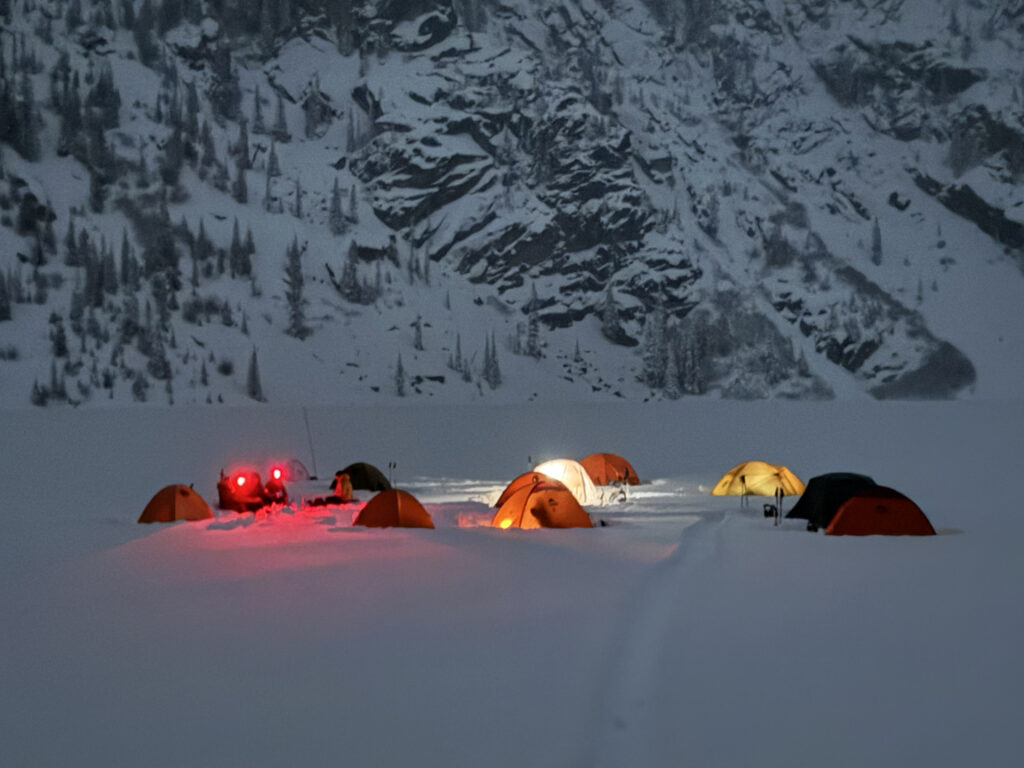
The Leipen Air Raiz 1
I have long maintained that the 4-season tent most ideally suited for backpacking in PNW winter conditions is the Snow Peak Lago 1, once made by Snow Peak and originally designed for mountain climbers. The good news is that there are other companies in Japan making a similar tent, one of which, the Leipen Air Raiz 1, that can be shipped to the USA.
In Japan, the Leipen Air Raiz 1 sells new for ¥42,900 or $325 USD (update: ¥50,600 = $323.71 June 8, 2024). Presently, no retailer is selling it in the USA, although a few are showing up on eBay for around twice the price ($450–650 range). However, it can be found on the Japanese Amazon site (orange and green) and on the websites of other Japanese retailers, some of whom may ship to the USA (you can use Google Translate to try to navigate their websites).
Remco, one of the hikers in our Winter Backpacking Meetup, bought the one shown here (Green one below) on its first tryout.
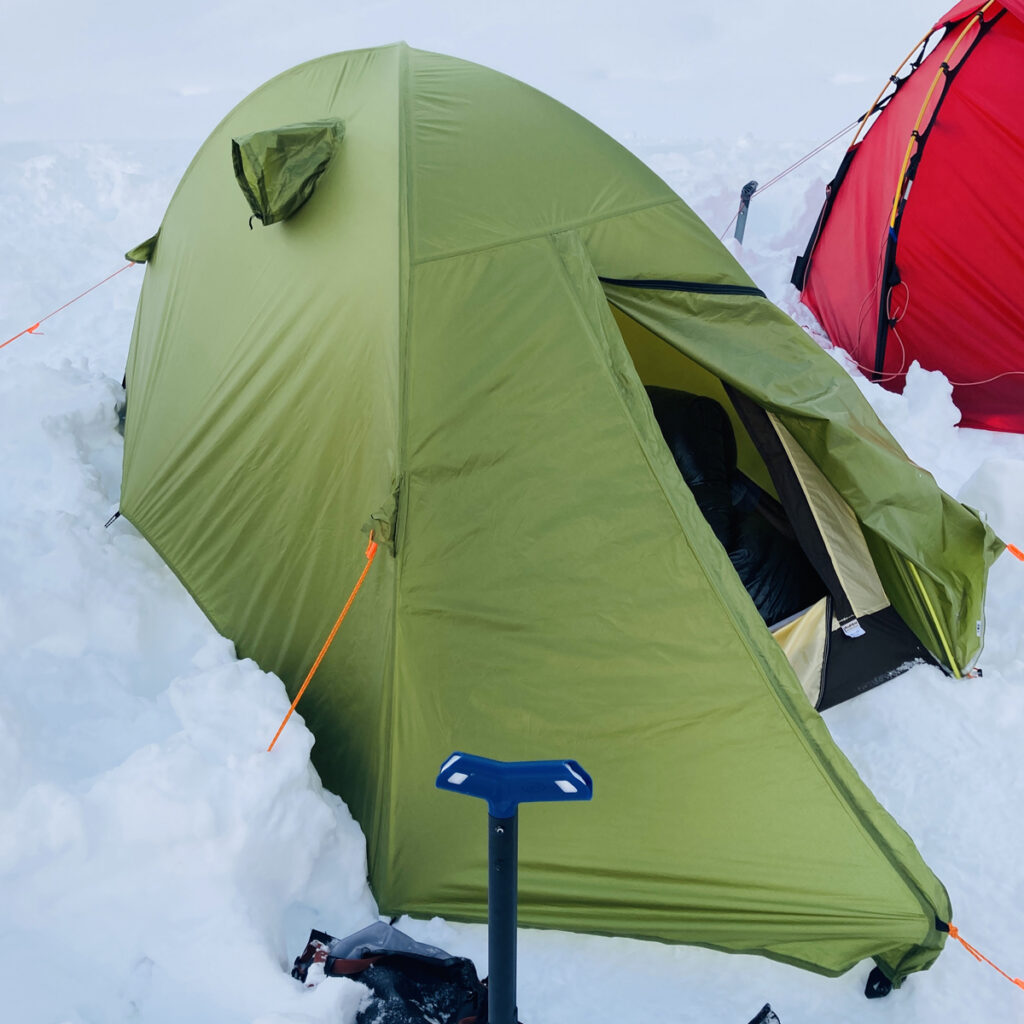
Unlike the earlier Lago 1, this design has a side vent and a tent vestibule built into the fly. The fly also extends low to the ground on all sides providing more rain and wind protection.
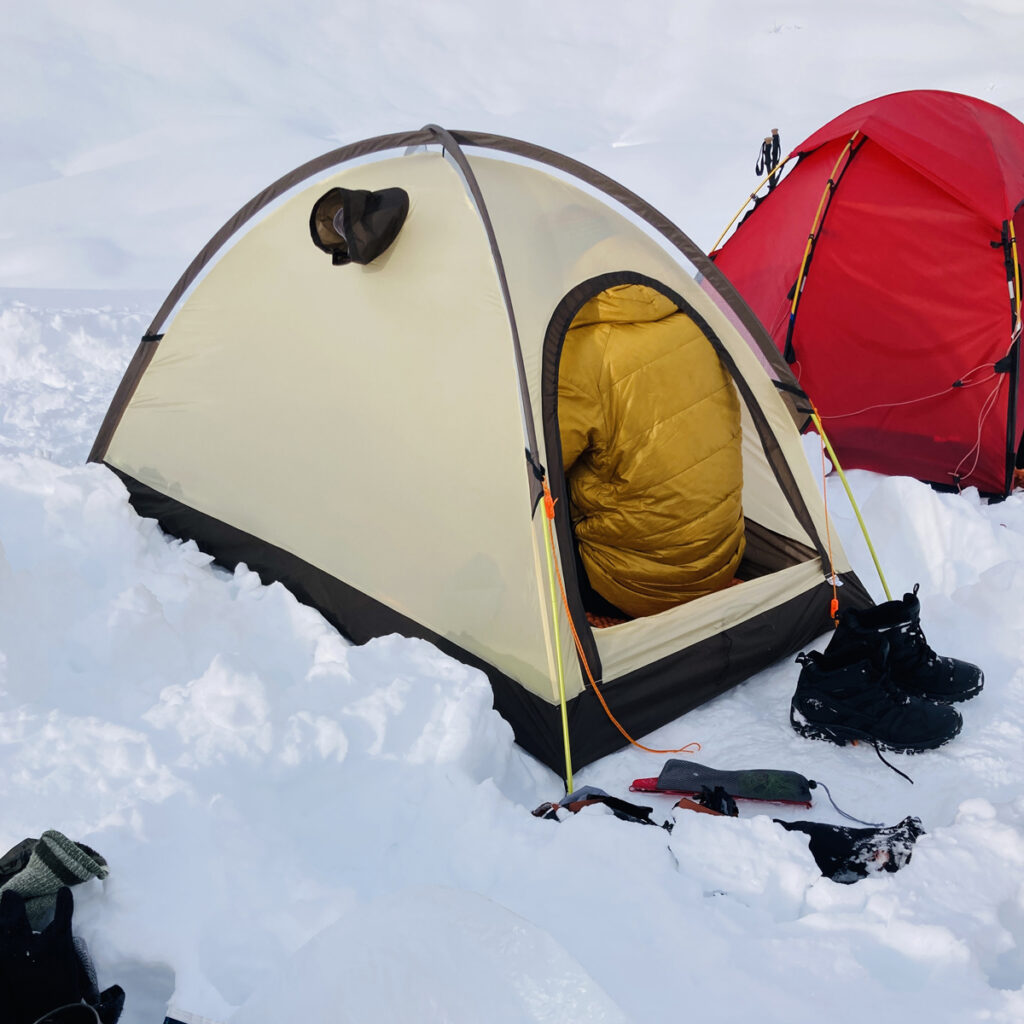
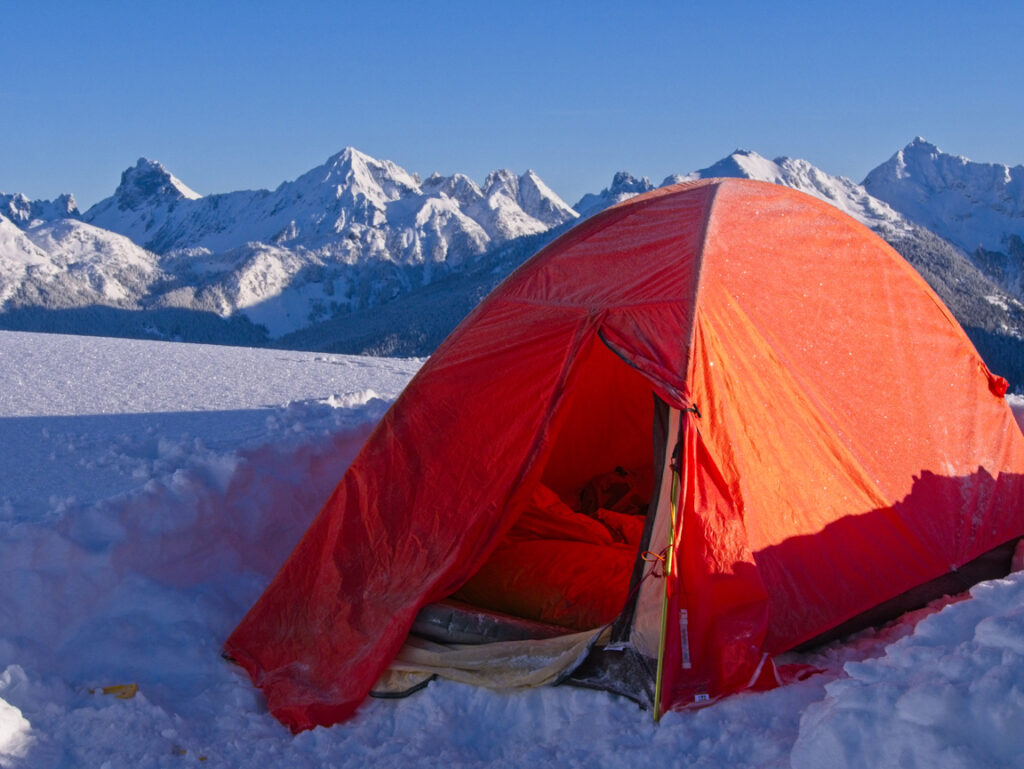
Leipen Air Riaz 1 Size and Weight
The Leipen Air Raiz 1 is two to three inches shorter than American options: L 80.3″ x W 39.4″ x H 41.3″ inches (205 x 100 x 105 cm) or 6′ 8″ inches long. Overall, the design and weight (3 lbs 5.6 oz) are nearly the same as the Snow Peak Lago 1 (3 lbs).
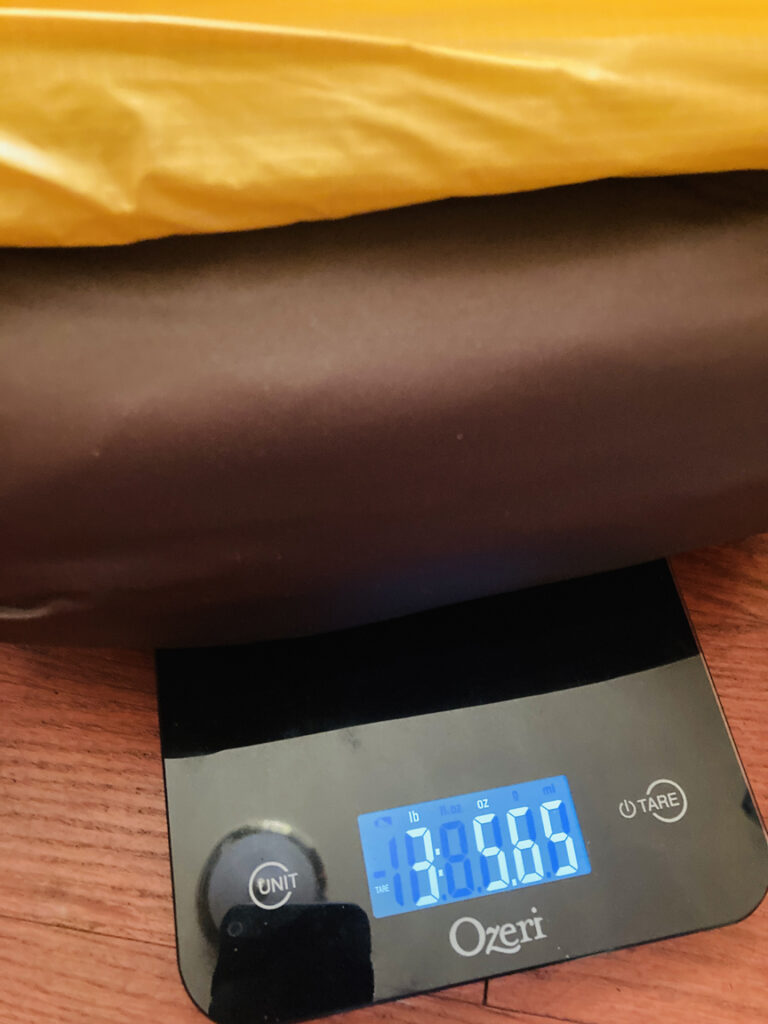
If you are tall, six feet or above this tent may feel a bit short. If you fit comfortably on a regular-size Thermarest NeoAir sleeping pad, the length is fine. It is a solo tent, but it is roomy enough to put two Thermarest NeoAir sleeping pads and air mattresses next to each other. If the manufacturer wanted to make a true solo tent, they could shave off more weight.
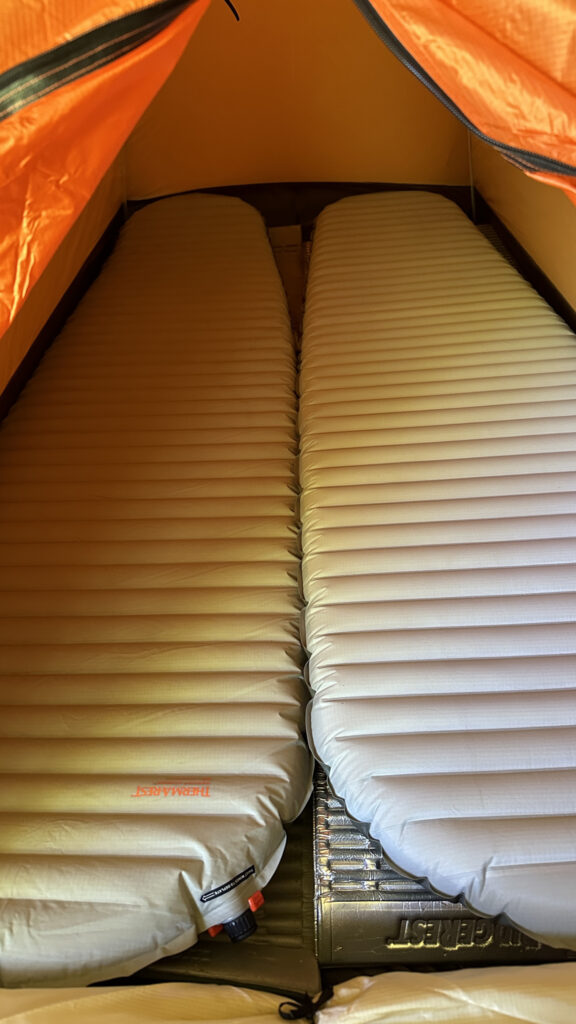
Comparisons
Here are some comparisons with what I regard as the main competitor 4-season solo tents.
Leipen Air Riaz or ARAI (1360 Grams / 3 lbs, Y50,600 = $323.71 June 8, 2024)
- Width 39.4 x Depth 80.7 x Height 39.4 inches
Black Diamond FirstLight 2P 4-Season (3 lbs 6 oz, $449.95)
- Width 48 x Depth 82 x Height 42 inches
MSR Access 1P 4-Season (3 lbs 8 oz / $679.95)
- Width 33 x Depth 83.8 x Height 40 inches
MSR Advance Pro 2P 4-Season (3 lbs 3 oz / $799.95)
- Width 42 x Depth 82 x Height 44 inches
Big Sky International Chinook 1P (3 lbs 7 oz / $749.95)
- Width (head) 36, width (foot) 24 x Depth 91 x Height 39 inches
Tent pegs
Bear in mind that the tent weight given above (3 lbs 5.6 oz.) includes 13 aluminum tent pegs. Ditch these heavy pegs for lighter and fewer snow pegs.
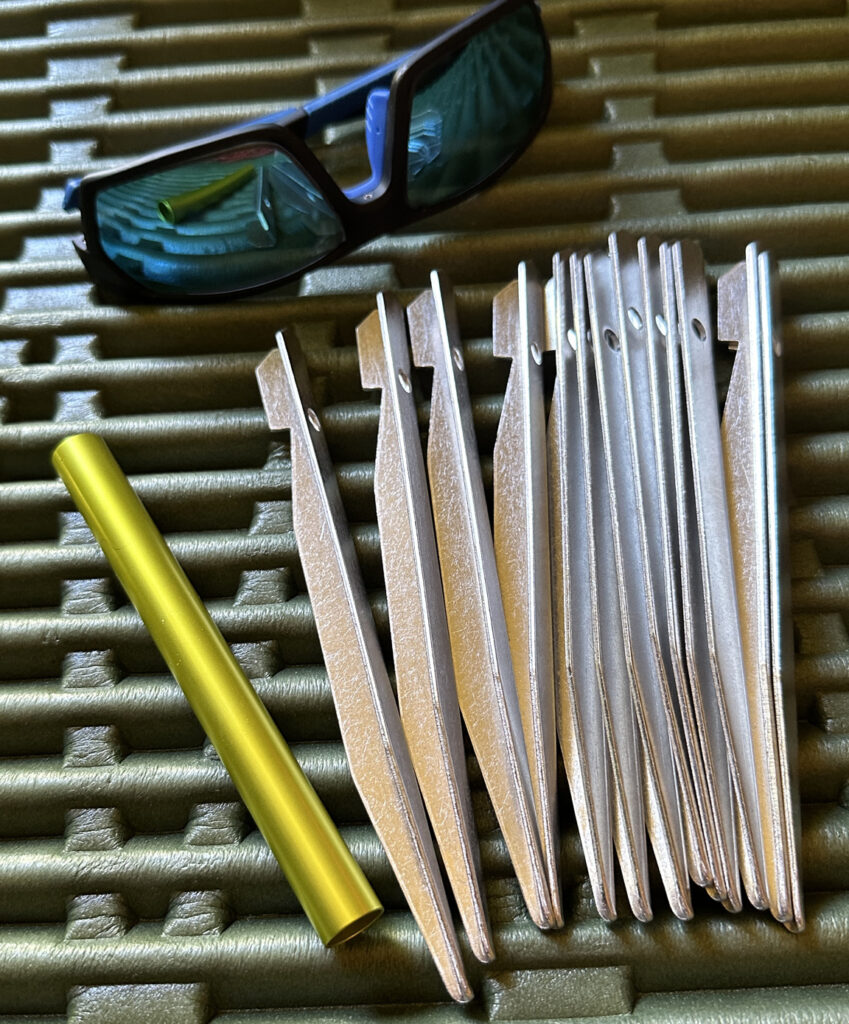
Unless there are really high winds, I’m only likely to pack 8 tent pegs and I would either take lighter titanium ones or, for snow, the Coghlan snow pegs.
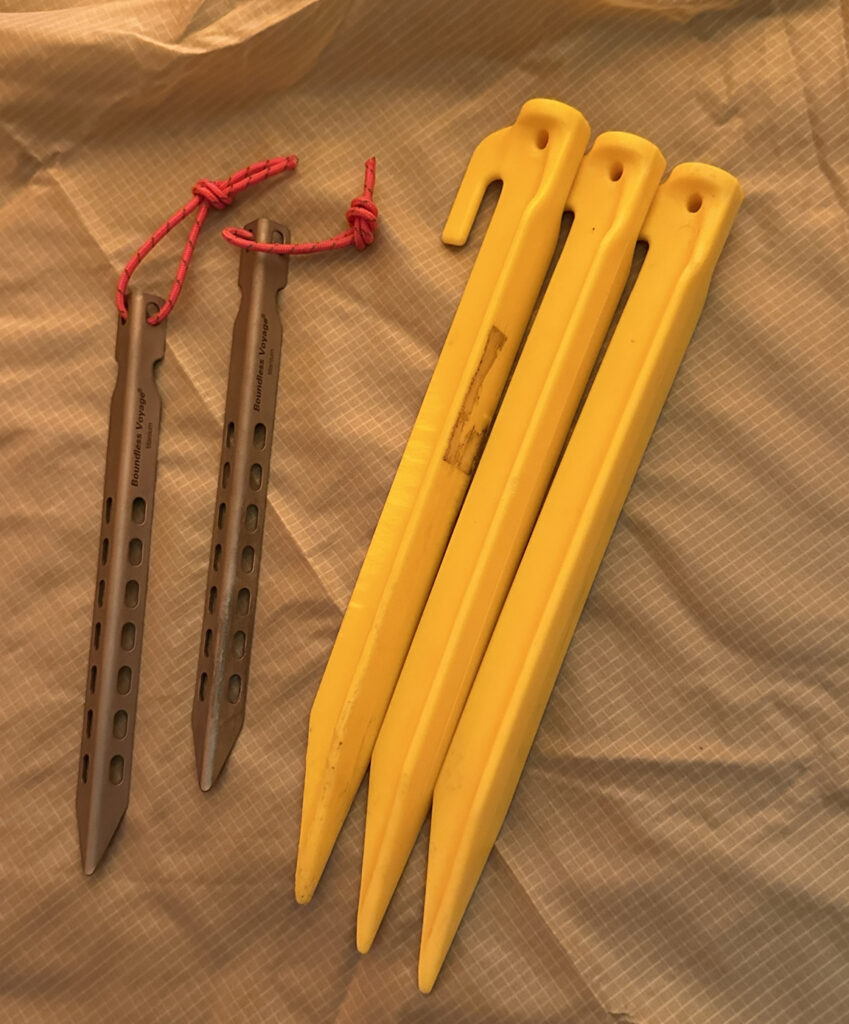
Mosquito Netting
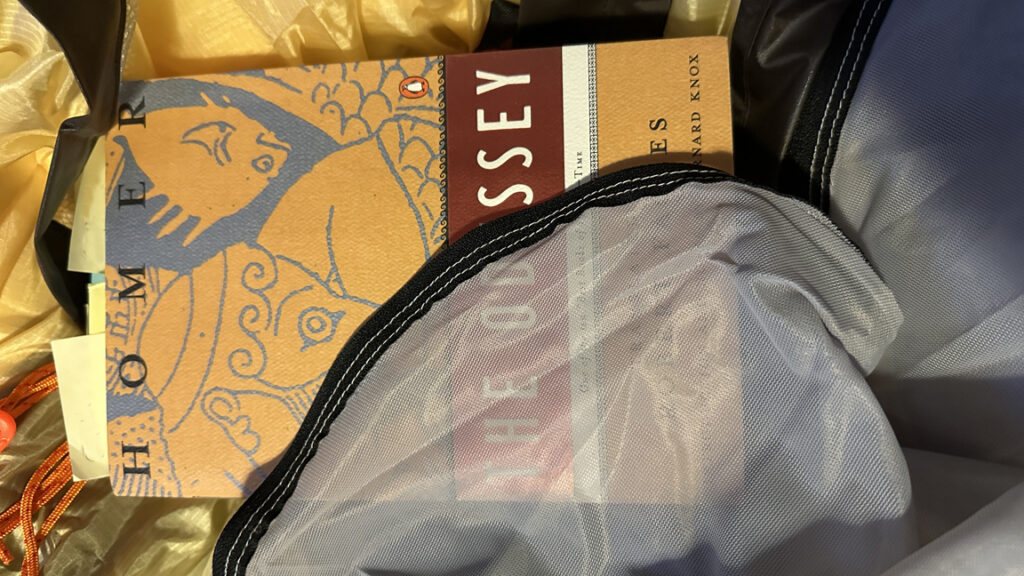
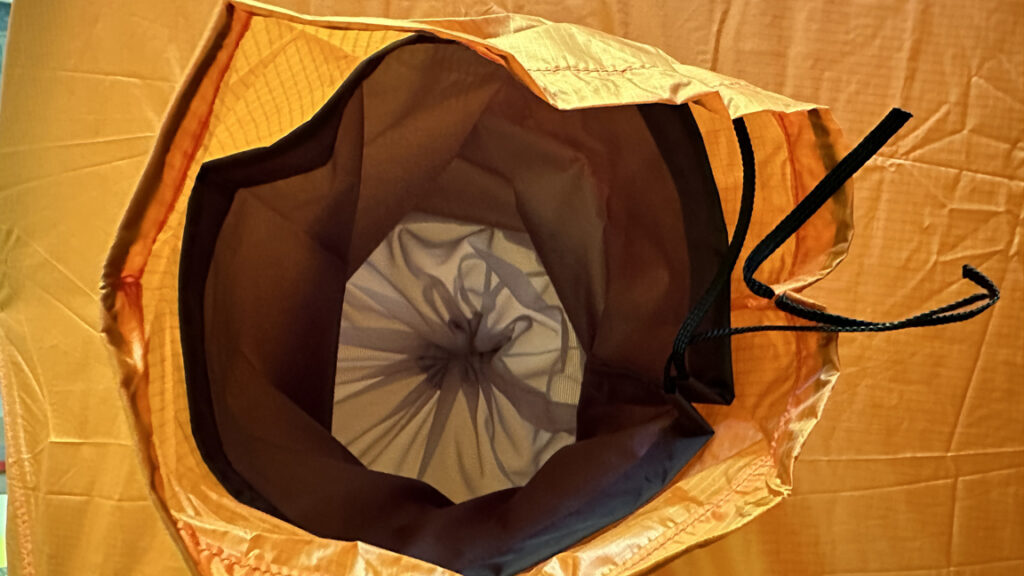
Differences between the Lago 1 and Riaz 1
There are a few differences to be aware of.
First, the Leipen Air Raiz 1 is short: L 80.3″ x W 39.4″ x H 41.3″ inches (205 x 100 x 105 cm) or 6′ 8″ inches long.
By comparison, the MSR Advance Pro 2 is L 82″ x W 42″ x H 44″ (208 x 107 x 112 cm). The older Snow Peak Lago 1 is L 89″ x W 36″ x H 40″ (226 x 91.4 x 102 cm according to an internet review). My own measurement is roughly 84 inches in length.
The Leipen Air Raiz 1 seems to be designed for shorter people, which is fine for me, but if you are 6 feet tall or above, the 6-feet 8-inch length is likely to leave your sleeping bag touching the back wall of the tent.
There is a another Japanese tent, the Mont-Bell StellaRidge 1 that is 82.6 inches long (210 cm). It also has a double wall with vestibule, but they don’t ship outside of Japan. The tent and fly are sold separately (with the fly not fitting models manufactured before 2019). A few show up on eBay, but at a much higher cost, around $815 complete (tent and fly sold separately)
The largest option is the Big Sky Chinook 1, 91″ x 24/36″ x 39″ (230 x 92/60 x 99 cm). The Chinook has more floor space but is not quite as tall for sitting up.
Second, although the fly has the vestibule and superior rain and wind protection, rain is usually not a problem and the added protection may cause more condensation. However, this may not be an issue, because all sides of the tent under the fly are breathable, whereas on the Lago, only the sides breath. More use is needed to determine the degree of condensation.
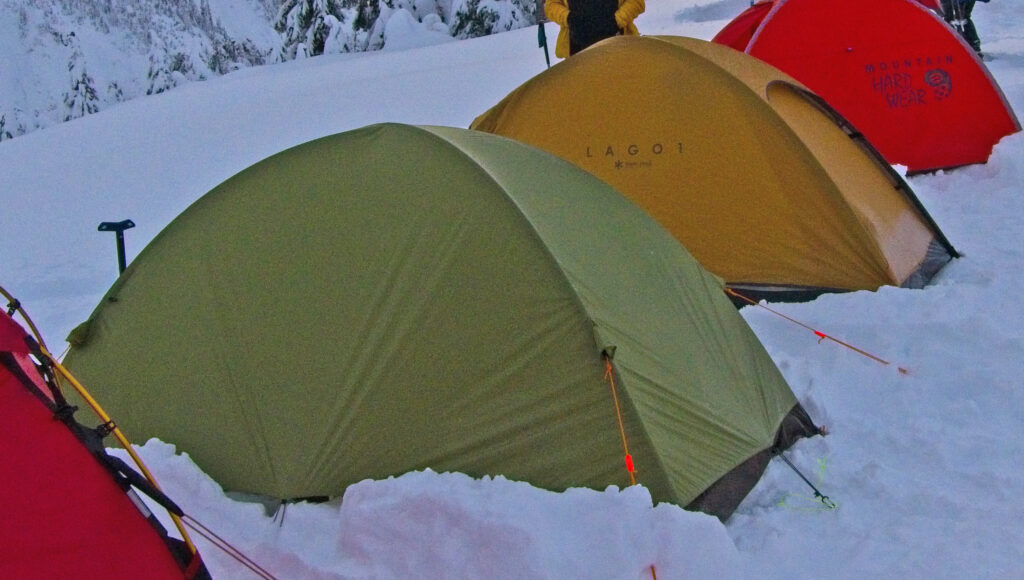
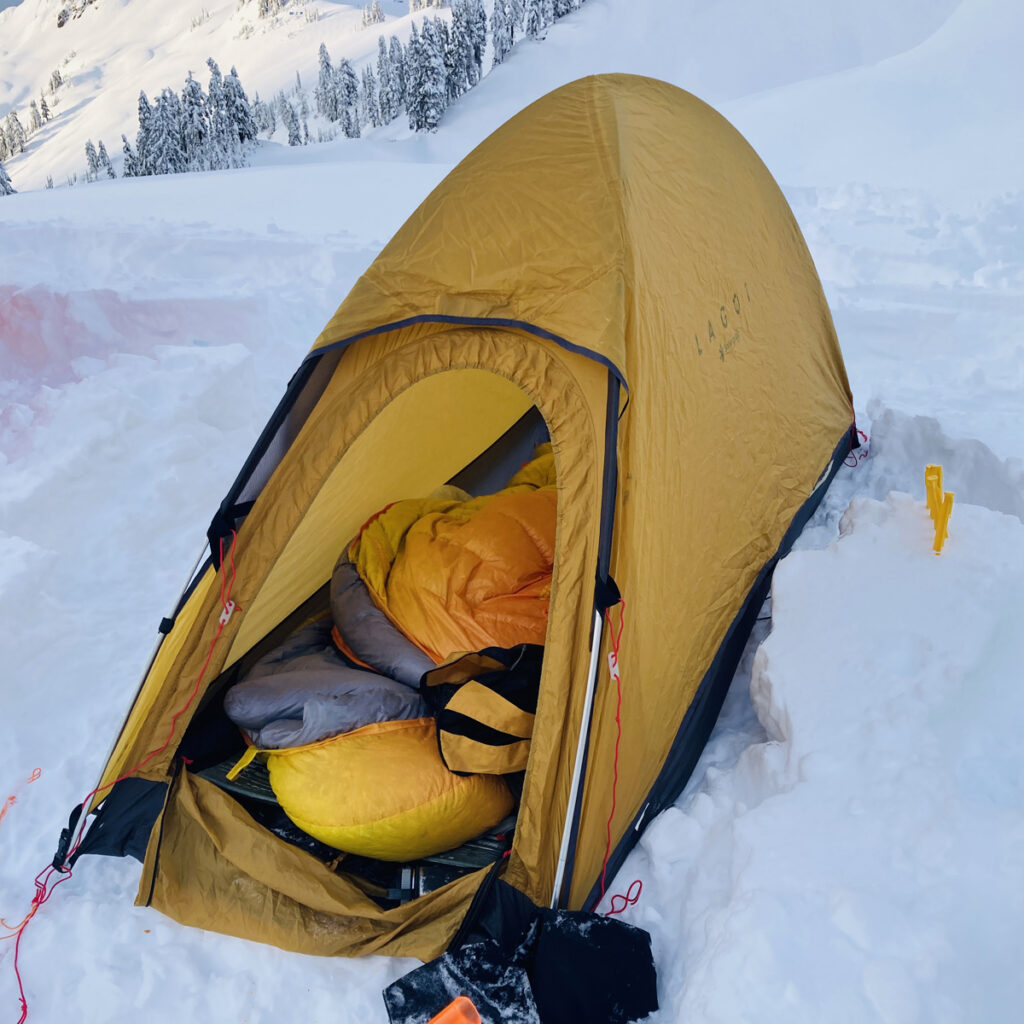
For more about winter tent options see “3-Season vs. 4-Season Tents.”
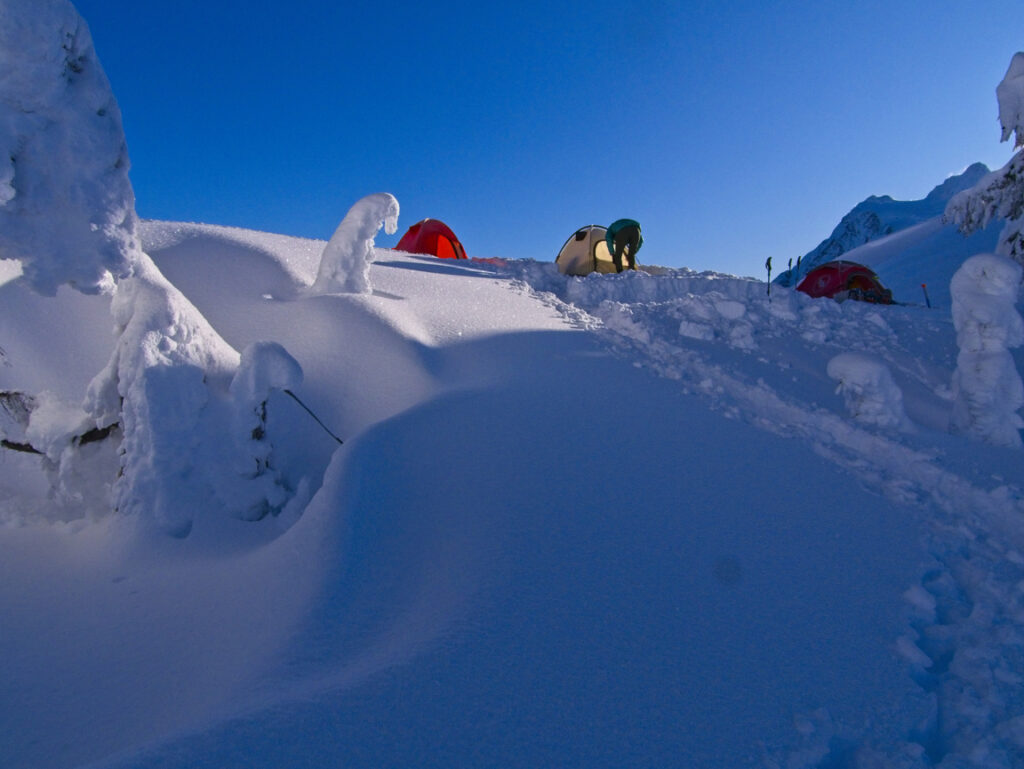
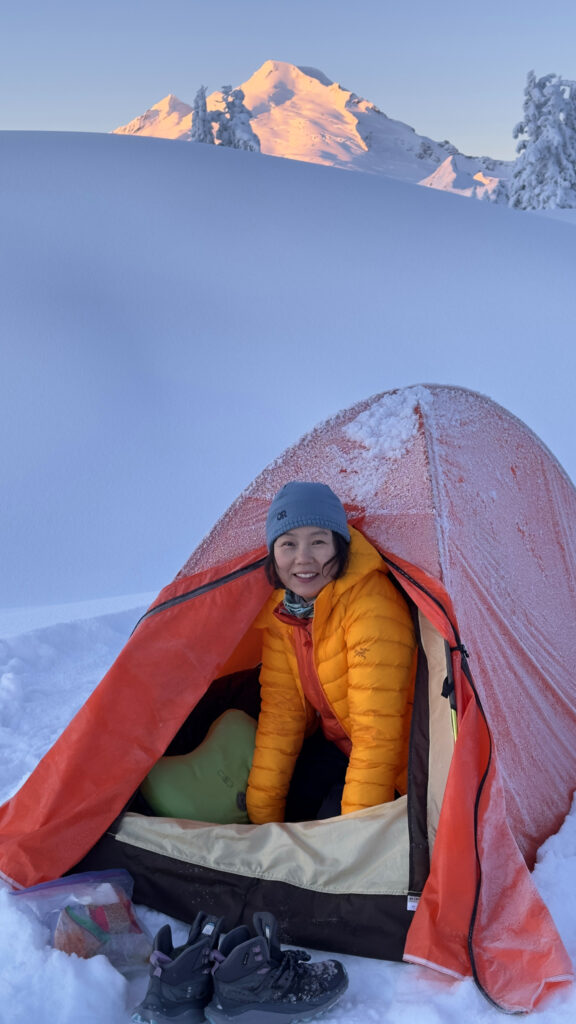
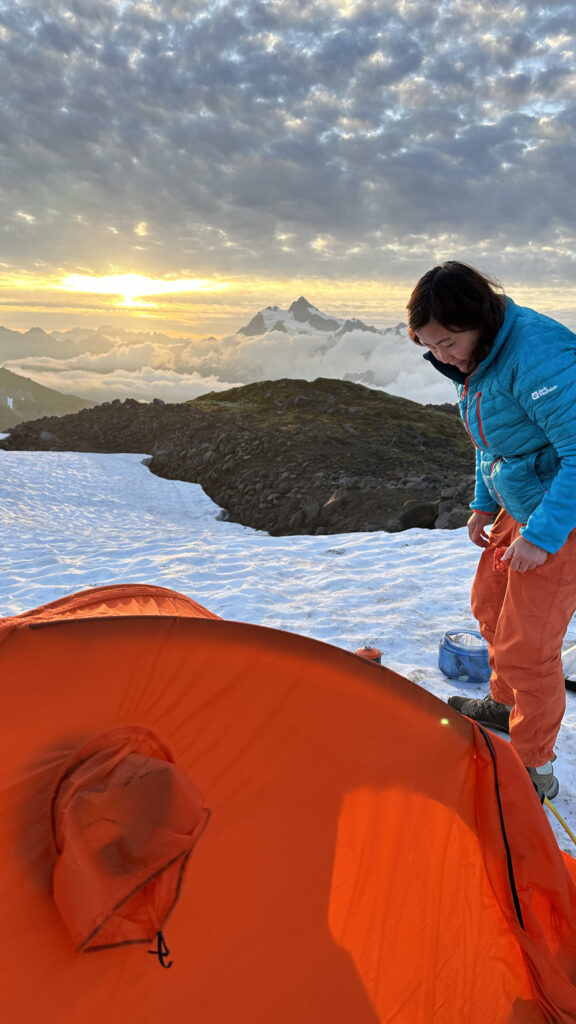
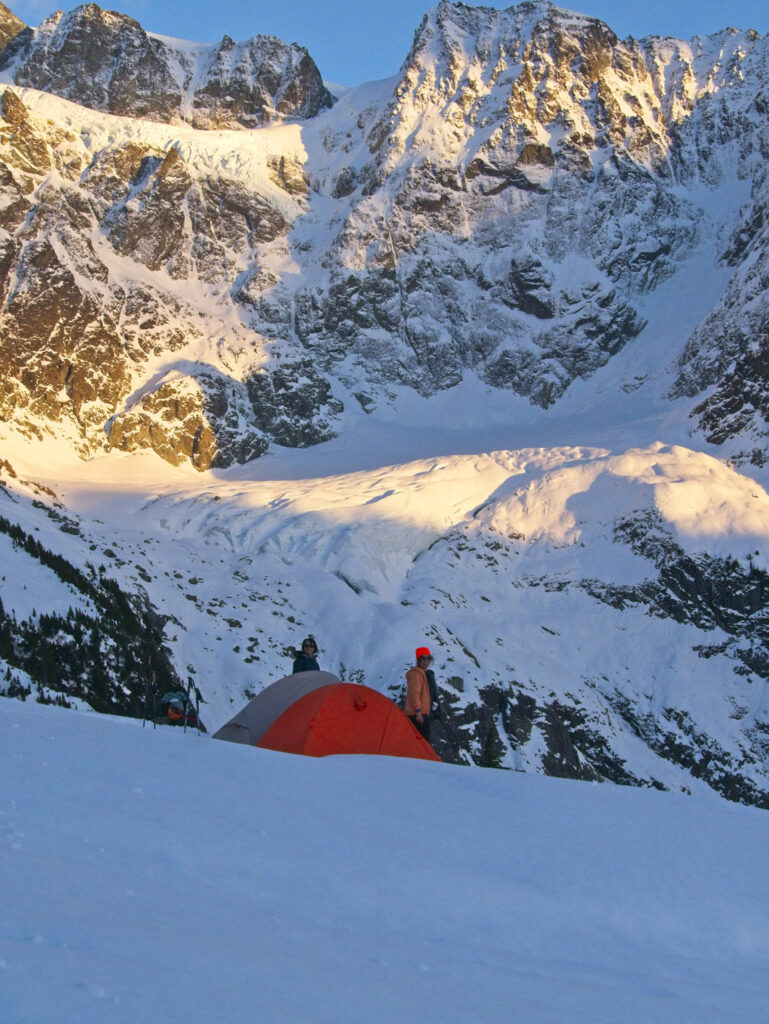
Please comment below
If you have any suggestions or questions, please let me know. I look forward to hearing your thoughts.
*Just so you know, there is no financial incentive behind any of the gear recommendations on this website. No company sponsors my reviews. In this case, I now have a Leipen Air Raiz 1 tent because I chose to buy it.
15 replies on “Four-Season Tents 2023 Update”
Hello Michael. Great job you do testing winter equipment. We live in Norway and some of your equipment is unknown for us. Just want to inform you about our wonderful tent from the tentmaker HUSKY in Cz. We got our Extreme Fighter 3-4 this winter and just love it. Heavy, yes, but good quality poles and fabric. Take a look at our pictures on insta @2fjellreker. All the best from Birthe and Kare
Thanks! Nice insta pics. I can see that a heavy tent is not as challenging where you are because you can use a pulk. A 10.5 lb tent would be hard going here in the Cascade Mountains. Our terrain is steep and the valleys full of trees. There’s not much flat terrain. We have to carry everything in backpacks so weight is a major consideration.
Thank you so much for the review! Is there any bug netting on the Leipen Air Raiz 1?
Excellent question. Yes, it has a double door, each with its own zipper. The inner door is a tight weave mosquito net. It will give you some visibility, but not as much as the type of loose mosquito netting that goes over a hat. I added a photo showing the mosquito netting.
Thank you Michael for the helpful information! I just ordered an ORANGE Leipen Air Raiz 1 on the Amazon JP site. Today’s price ¥50,600 + shipping, a Total ¥57,881. I paid $406 USD. I do need to register a new account to be able to check out.
I look forward to having Winter backpacking adventures with you all.
Thanks Lili! Countries everywhere have been raising interest rates so the dollar is loosing its import advantage. Still a reasonable deal compared to other options. I hope you get to enjoy the tent this winter.
I have Osteoarthritis both knees.
What tents would you recommend
for Me, I love camping? I’m 5’8″ Tall.
Please let me know what to purchase.
Sincerely, John
Hi John. Sorry about your Osteoarthritis problem. I’m not sure if any tent would ameliorate your difficulties with Osteoarthritis. That aside, if you are looking for a 4-season solo tent, I recommend the Samaya Radical 1, especially for climbers and anyone who needs to reduce pack weight. If you require a more all-weather tent, the double wall Leipen Air Raiz 1 is an excellent choice for the money. If you want more floor space consider the Big Sky Chinook 1. I hope that helps.
Hi,
on the topic of winter tents in general, what do you think about tunnel tents? Hilleberg Nallo or Nammatj would be two such examples. I am a Nordic hiker, and here tunnel tents are the default for winter hiking. One major advantage of tunner style tent is that one can assemble it flat, i.e. you stake one end, put the poles in place with the tent flat on the ground, and then pull the tent up and stake the other end, meaning it is relatively easy to pitch in a high wind situation. Many dome tents seem to pitch inner first, which for me would seem like a big downside for the design, but you seem to be fine with that.
One issue with tunnel tents is that those designs in practice seem to be more weight-efficient for 2p -designs, and you seem to favour 1p tents. The 1p Akto seems pretty tight for winter use, but then again, so seem those mountaineering tents you seem to favour.
Hi Jesse
When you say you’re a Nordic hiker, does this mean you are hiking in Scandinavia, Finland, Iceland? Whatever may be the case, I hope you will share some of your winter adventure photos and experiences on our Facebook group page.
From a tent set-up point of view, staking out a tent in deep snow is challenging. So I don’t want that tasks in high winds. With a free-standing tent (preferable an x-frame design), I can set the poles, throw my pack inside to weight it, and climb in. Once inside, I can change into my camp layers and then go out, secure the tent with deep dead-man pegs, trim the fly, and build a snow wall if needed. Now, if you are dealing with gale force winds (39-46 Mph/62-74 kph), then maybe the lay flat system has an advantage. In most situations, I’m only in 10–20mph winds.
Aside from setting up the tent, the only Hilleberg tents I would consider are the Enan solo tent ($720, 1.2 kg/2 lbs 10 oz) or Akto ($635, 1.7 kg/3 lbs 12 oz) because these align closer with the 3-pound rule. The Hilleberg Nallo ($855, 2.4 kg/5 lbs 5 oz) and Nammatj ($925, 3.0 kg/6 lbs 10 oz) are just to heavy for winter backpacking. If you’re on skis pulling a polk on relatively flat or gradual terrain, then these heavy bomb-proof tents are probably more attractive. But here in the Pacific Northwest, we are backpacking in steep terrain. We’re not using polks. Everything is in the backpack. So getting our winter backpacks down to 25–35 lbs (roughly 12 kg–16 kg) is a priority.
I think most people here favor the 1-person tents because they are lighter. The Leipen Air actually seems roomy to me, especially compared with the Samaya Radical1. For long winter nights, the extra space is appreciated. Samaya is the only company offering spacious 4-season tents that are under 3 pounds.
Hi Michael! I bought the Leipen Air, and I’m excited about it! But I’m wondering, did you use the seam sealer that came with it or a different one? Curious if you have any recommendations about this. Thanks!
Hi KS. I hope you enjoy your new tent. I did not use the seam sealer because I am only using this tent in snow and winter conditions and not rain. However, another hiker in our group has the tent and he tested it with a garden hose and in overnight mild rain in his backyard and said there was no leakage. He thinks the sealer is unnecessary. I have no plan to use the sealer.
That’s helpful – thanks, Michael!
One more question for you – have you had the chance to test the tent in strong winds, and if so, how did it hold up?
Sorry KS. I just now noticed your second question. Thus far I have not used the Leipen in high winds but I have used the similar Lago 1 tent in 20–35 mph winds many times with no problems. The x-frame design is strong. I expect it can handle unexpected gale force winds but if the forecast is gale force I’m probably going to stay home.